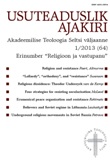Religion and resistance: introduction
Religion and resistance: introduction
Author(s): Riho Altnurme, Irina PaertSubject(s): Christian Theology and Religion
Published by: Akadeemiline Teoloogia Selts
Keywords: Religous Studies; Church History
Summary/Abstract: The introductory article, reviewing the key themes of the articles in this special issue, points out that there is a profound ambiguity about Christian understanding of resistance. Theologically, resistance has been understood in ethical terms as a reversal of the ideal of heroic vengeance and retaliation. However, the ethical imperative of love for one’s enemies has rarely been fulfilled in practice. In the history of Christianity, resistance can be located in three types of relationships: the relationship between religion and the state; the relationship between the established church and various dissenting or non-conformist groups; and, finally, the relationship between the secularised society and religion. As some articles in this special issue point out, resistance was not the attribute of the dissenting groups alone. On the one hand, the established churches used “reciprocal resistance” to counter dissent; on the other hand, the nonconformists often elicited more support from the civil and religious authorities than the term “religious dissidence” may lead us to think. In the same vein, resistance of the church to the secular world needs to be redefined. The secular and the religious have not always been antagonistic to each other. The ways in which Christian churches related to modernity were multiple and included adaptation to modern ideas and movements, as well as other more active responses. The twentieth century had become a test for the Christian ethics of non-retaliation, when churches and non-Christian religions had to define their position vis-á-vis the illiberal and totalitarian regimes in Europe. The last three articles in this special issue that discuss the role of religion in counteracting communism and fascism, bring forward some interesting themes, especially regarding the strengths and weaknesses of Christian ecumenical organisations, the role of Catholicism in mobilising social resistance to the Soviet regime and the close alliance between political and religious dissidence in the Soviet Union. In the final analysis, we maintain that the study of resistance in church history is far from complete and requires a robust comparative and theoretical effort.
Journal: Usuteaduslik Ajakiri
- Issue Year: 2013
- Issue No: 1 (63)
- Page Range: 3-11
- Page Count: 9
- Language: English

